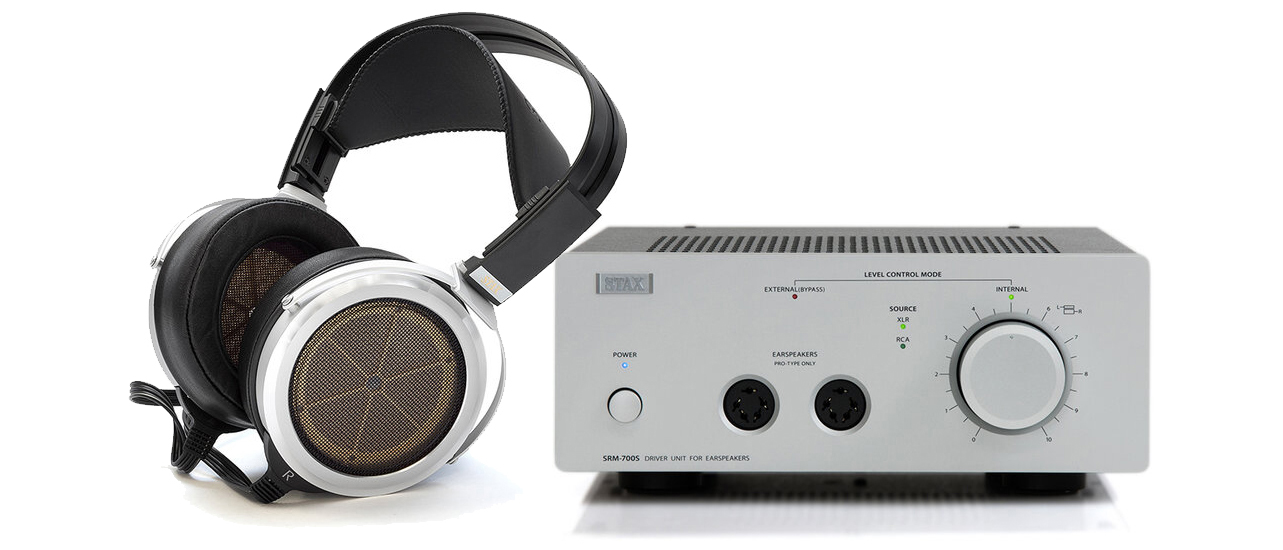What Hi-Fi? Verdict
While the experience you'll have with the SR-009S and SRM-700S pair is truly remarkable, there are certainly cheaper ways to enter into the world of electrostatic headphones – some of which are via alternative products from Stax istelf.
Pros
- +
Flawless sound
- +
High SPLs possible
- +
Dual outputs
- +
Valve & solid State options
Cons
- -
Rear-panel switches
- -
No stand-by mode
- -
Input switching
- -
Mute control
Why you can trust What Hi-Fi?

This review and test originally appeared in Australian Hi-Fi magazine, one of What Hi-Fi?’s sister titles from Down Under. Click here for more information about Australian Hi-Fi, including links to buy individual digital editions and details on how to subscribe.
SR-009S tested at £3895 / $4325 / AU$7750. SRM-700S tested at £3060 / $3400 / AU$5900.
There’s a saying about electrostatic headphones. It’s that once you’ve owned a pair, you’ll never settle for anything less. And in the electrostatic world, Stax earspeakers surpass all other designs in both sound quality and build quality. There are reasons for this.
Firstly, Stax refuses to compromise on quality. Indeed this refusal to compromise meant that at one time its products were simply so expensive that their sales could not support the cost of production, and rather than produce a lesser-quality product, the company ceased production (in 1995) until support came its way in the shape of an injection of capital from Chinese headphone manufacturer Edifier.
Stax also refuses to compromise its identity. By this we mean that having been manufactured in Japan since 1928, the company continues to insist that all products bearing the Stax name must be manufactured entirely in Japan. This nationalistic ethos obviously increases production costs.
So what was the company to do when its philosophies meant that the price of its top-line electrostatic earspeaker driver, the SRM-T8000, crept up into the price-point territory that caused the company its financial woes a few years back?
The answer is one of the subjects of this review: the SRM-700S. Whereas the SRM-T8000 is a valve-based unit, the SRM-700S is all solid-state, indeed it’s the first product Stax has ever manufactured that uses a particular type of solid-state device (a J-FET) in its second stage (following low-noise dual FETs in the first stage).
But the SRM-700S is also somewhat stripped-down in terms of features, because the more expensive SRM-T8000 has three switchable inputs, as well as a mute circuit.
But in creating a lower-priced unit, Stax didn’t want to alienate all those audiophiles who specifically wanted the valve sound that was inherent in the SRM-T8000, so at the same time it was designing the SRM-700S, it also designed a valve version: the SRM-700T. The SRM-700T is mostly identical to the 700S, but 6SN7 valves are used instead of FETs in the second stage.
As valve aficionados will already know, the 6SN7 is a medium-gain dual-triode designed in the 1940s that fell out of favour with circuit designers when the 12AU7 and 6CG7 types were released a decade later. It was reintroduced in the 90s by designers who wanted to take advantage of its microphonics to deliver a classically rich and warm sound that was audibly different to solid-state.
At this stage of this review, we are betting that you’ve already guessed that an ‘earspeaker’ is simply another name for a headphone. And you’d be correct. Stax has always called its headphones earspeakers, primarily because at the time they were introduced, the diaphragms were so large that they were, essentially, miniature loudspeakers, whereas all other headphones had such small diaphragms that they were more like souped-up hearing aids.
These days, many other headphone manufacturers now use large diaphragms, so Stax doesn’t have the field to itself, but the word is now so much a part of the brand’s identity that it would be foolish to change it.
But unless you’re familiar with electrostatic driver technology you probably haven’t worked out exactly what an electrostatic headphone driver does, other than guess that you need one to drive a pair of Stax earspeakers.
Basically, nearly all (and we’d guess that ‘nearly all’ would be a figure in the region of 99 per cent) of the full-sized, over-ear headphones available use what are called ‘dynamic’ drivers, where the current flowing through a length of wire attached to a diaphragm interacts with a permanent magnet and causes the diaphragm to move back and forth, which in turn creates the sound you hear. It’s a very simple technology that’s been around for more than a century.
Stax does not use this technology in its earspeakers.
Stax earspeakers are electrostatic. In this system, a ‘driver’ unit is used to create electrostatic charges on two plates (called stators) and the resulting electrostatic field is then used to move the diaphragm.
If you’ve ever rubbed a nylon comb on a piece of wool and used it to attract a tiny piece of tissue or a bead of foam, you’ll already know that electrostatic fields are far less powerful than magnetic ones so you need very high voltages to create fields that are sufficiently strong to move a diaphragm.
In the beginning, Stax used voltages of around 200 volts to create its electrostatic fields, which worked fine, but meant that you couldn’t play music too loudly through them due to the limited voltage. This really didn’t matter too much until rock music changed listener’s expectations of how loud music should be played.
So Stax decided to satisfy the demand for louder sound by upping the voltages used to create the electrostatic fields. The result is that the voltages generated by current Stax electrostatic headphone driver amplifiers vary a little between models, but they’re all around three times higher, at around 600 volts. The SR-009S is the evolution of the SR-009, but we’ll get to that in a moment.
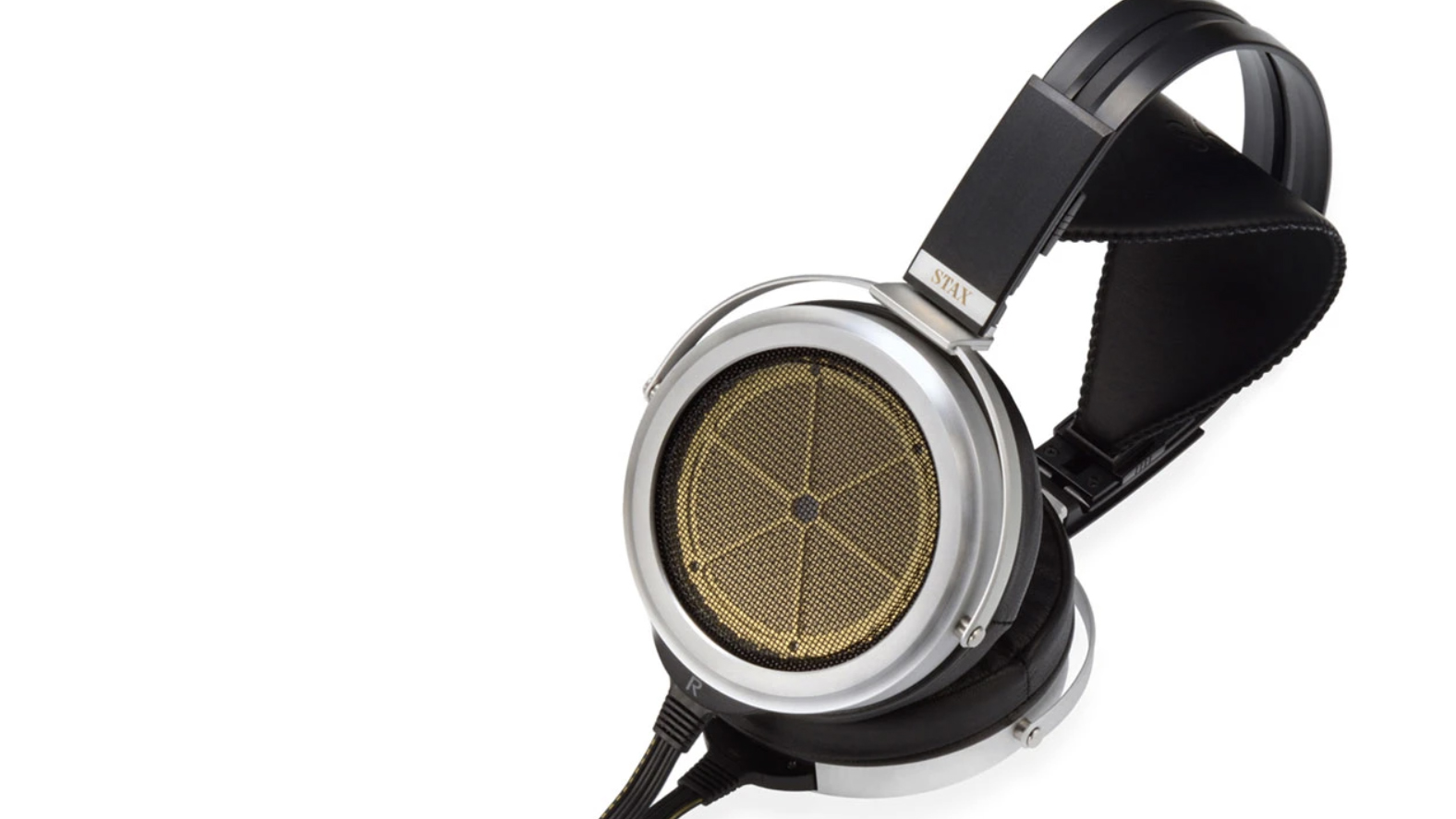
SRM-700S Driver Unit
The SRM-700S’s enclosure is quite ‘old-school’, with an anodized aluminium fascia for the front panel and grey/black coated steel for the chassis, but the quality of the build is exceptional... particularly that of the fascia.
You rarely see anodising of such high quality these days. As you can see, the front panel is utilitarian, with exactly what you need on it and no more. There are two sockets for headphone connection, a power switch, and a volume control. That’s all.
Well, that’s not quite all, because the volume control is actually a dual-gang control with inner and outer segments, so that it can also function as a channel balance control.
There are five LEDs on the front panel. The one above the power switch is blue. Just to the left of the volume control are two green LEDs, one above the other. These are used to indicate which line input is active: balanced (top-most LED) or unbalanced (bottom-most). Switching between the two is via a rotary switch on the rear panel.
The two remaining controls indicate whether the volume control is in-circuit. If the SRM-700S’s control is active, then the green LED above it glows. If you’ve disabled the SRM-700S’s own volume control, and are controlling volume externally via another means, then a red LED almost above the headphone sockets illuminates.
We liked the fact that one LED is green and the other red, because the red color is a good warning about the potential for unusually high volume levels. Level control switching is also controlled via a rotary switch on the rear panel.
It would be remiss of us not to point out that the sockets on the SRM-700S do not have the old (6th) centre-pin you’ll find on early-model Stax headphones, because it’s designed to drive only the new ‘Pro’ Stax headphones, which require the much higher bias voltage than the early model units, as mentioned earlier.
Stax very sensibly did this specifically so you could not do any damage by plugging in a pair of lower-voltage older (pre 1992) models (usually referred to as ‘Normal’ bias models).
You can, on the other hand, use a pair of modern, ‘Pro’ bias models with an old, ‘low-voltage’ headphone driver, but performance will be compromised.
We don’t think we would have mentioned an almost 30-year old product if we were reviewing any other brand of headphone, but Stax’s reputation (and build quality) is such that there are plenty of older Stax models available for sale on the second-hand market. If you check this market out you should not expect to find any bargains: Stax’s prices are high even second-hand.
The rear panel of the SRM-700S has standard XLR balanced inputs arrayed vertically, gold-plated unbalanced inputs (again arrayed vertically) and gold-plated outputs. The rotary switch that switches between them is located between them and operates an internal relay that does the actual switching.
This switch has a curious ‘dead’ setting between the two positions that we didn't much like, but it will have no impact on performance.
The other rotary switch (volume bypass) is a completely different type that also operates a relay and doesn’t have the same ‘dead’ spot midway between the two positions. There’s also a large ground terminal on the rear panel plus a standard 240V a.c. socket.
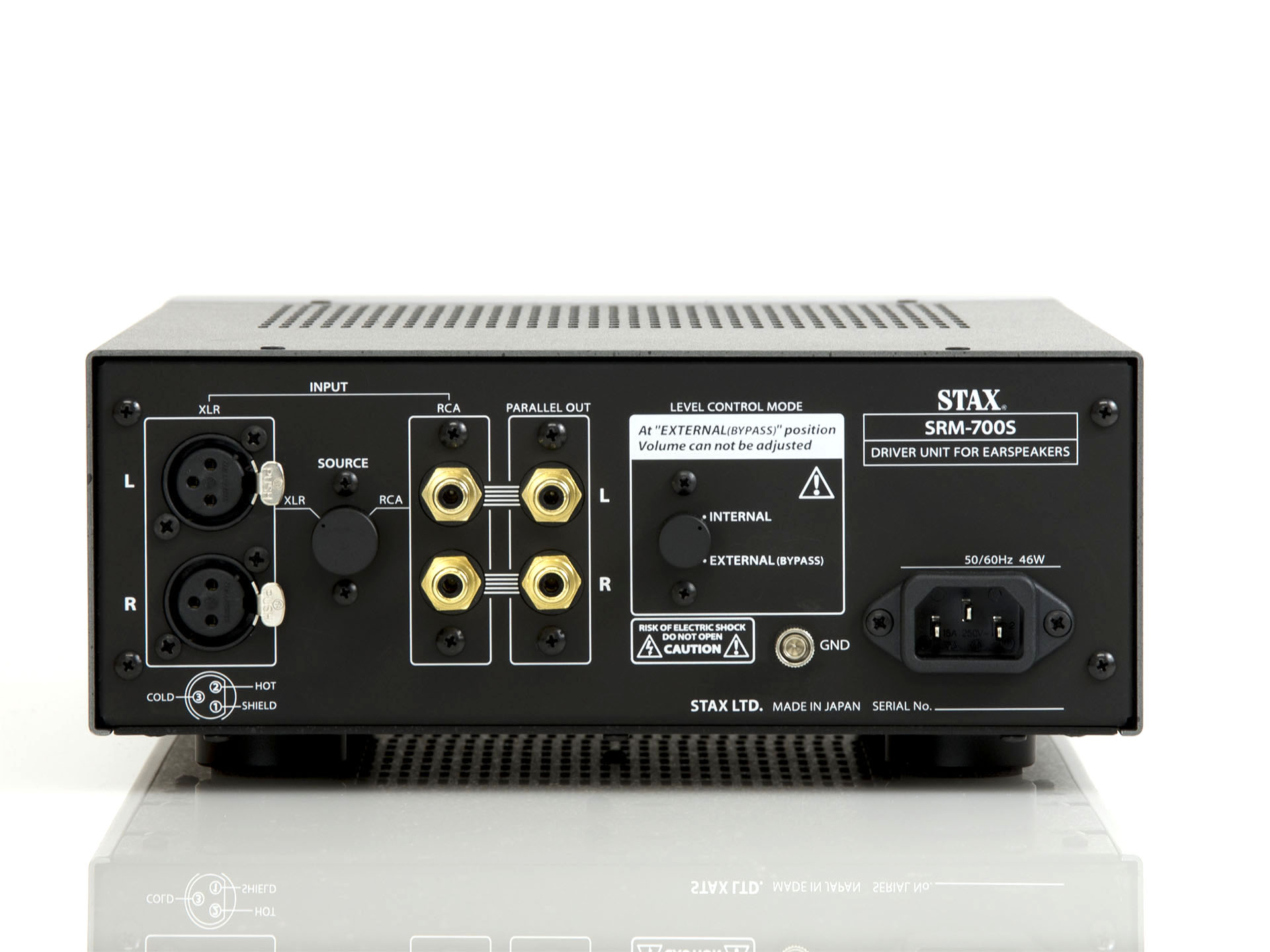
SR-009S Earspeakers
The Stax SR-009S is, as you’ve probably guessed, a step up from the SR-009 model. They of course have the typically large earpieces necessary to accommodate the equally large electrostatic diaphragms and although this means they’re around 105mm in diameter, it does mean they can enclose even the largest ears.
Unlike most other electrostatic diaphragms (including some made by Stax itself), the ones on the SR-009S are circular, which is much, much harder to do, but ensures the tension is exactly the same across the entire diaphragm.
The diaphragm on the SR-009S is much thinner than the one on the SR-009, and the drive stators are gold-plated for higher conductivity, plus the edges of all the holes in the plates are rounded-off, rather than sharp-edged, so you get a superior electrostatic field.
As you’d expect of Stax, the earpiece pads are not made of synthetic material, or ‘faux’ leather, but real leather... and not just any leather either: Stax uses only pure first-grade sheepskin. This material not only forms a great seal around your ears, but also has a great ‘head feel’ and does not get sweaty even after extended use... or at least it didn’t with us.
But sweat must bother some listeners, since Stax points out in its Owners’ Manual “When troubled by sweat, you will feel better if several sheets of gauze are applied on the earpad.” And no, we have no idea how you’d go about doing this either!
The headband is the superior ‘dual band’ design, where the uppermost of the two bands is the structural component that holds the entire assembly together, plus it applies the side-force necessary to keep the earpieces firm over the ears while the lower of the two bands is used to adjust the height of the earpieces so they’re exactly centred over each ear.
These changes in construction have necessitated an increase in overall weight, and whereas Stax claims 441 grams without cable and 583 with, we measured 465 grams without the cable and 591 grams with it. Although this is heavier than average, we still found the headphones comfortable, but at the same time sufficiently heavy that we were never unaware that we were wearing them.
Speaking of which, we have to point out that everyone else in close proximity was also aware that we were wearing the Stax SR-009Ss because, as with all electrostatic headphones, there’s as much volume coming from the outside of each earpiece as there is from the inside. These are not the headphones to use if you plan to listen privately!
The headphone cable of the Stax SR-009S headphones is most unusual... and we loved it. As a long-time fan of liquorice straps, we're happy to report that the Stax cable looks exactly like a liquorice strap, and even feels like a liquorice strap, except that whereas real liquorice has a slightly sticky feel, the Stax headphone cable is perfectly dry. It's also far more flexible, and a little thinner than real liquorice, but in a blind ‘feel’ test, we think you’d be hard-put to tell one from the other.
The strap is permanently connected at the headphone end, but at the end that plugs into the driver unit, there’s a five-pin plug (that looks for all the world like the bottom of a valve) that plugs into the socket on the driver unit that also looks exactly like a valve socket, as we mentioned earlier when describing the SRM-700S’s front panel.
Actually we would not be at all surprised if these connectors are, indeed, repurposed valve sockets. And if they’re actually made specially for the purpose, they’re exactly the same as valve connectors, which is great, because valve pins and valve sockets, are about the best connectors around.
They’re fabulous mechanically, and fabulous electrically, and they’re specifically designed to remain so... no matter how many times you plug the two together. There simply isn’t a better connector.
Stax has upped the ante, however, by gold-plating both the pins and the socket terminals, so you will also get even-higher conductivity and zero corrosion, ensuring longevity.
Initially, we were a bit bamboozled about how to orient the plug with the socket until we realized the liquorice cable is coded, with a dashed line down one side, and a solid line on the other. Simply align the plug with the front-panel socket so the dotted line is to the right, and the plug slips into the socket smoothly and easily, and is held very fast by the five socket terminal.
It’s a thing of beauty. It’s also a thing of quiet. Unlike most headphone cables which, when moved, create a scraping sound in the headpieces (very, very annoying!) so you really need to keep perfectly still whilst listening, Stax’s ‘liquorice-strap’ cable is noise-less when moved.
Electrostatic diaphragms are typically less robust than ordinary dynamic diaphragms, so you need to keep your fingers away from the guard meshes, and ensure you prevent anything from pushing on the mesh, plus you should not drop the ‘phones or expose them to any mechanical shocks.
It would also be wise to keep the diaphragms as clean as possible, by either packing the headphones away when you’re not using them, or placing them on a suitable headphone stand, then placing a dust cover over both the ‘phones and the stand. Stax sells both stands and covers, but there are other aftermarket alternatives to these branded solutions.
If you choose to pack the headphones away, Stax suggests you use the wooden display box that the SR-009Ss come in. Made from a wood called paulownia (or, in Japanese, ‘kiri-bako’), these boxes have been used in Japan to store treasured belongings such as books, kimonos, art, rare metals and pottery for more than three centuries, and are prized possessions in their own right.
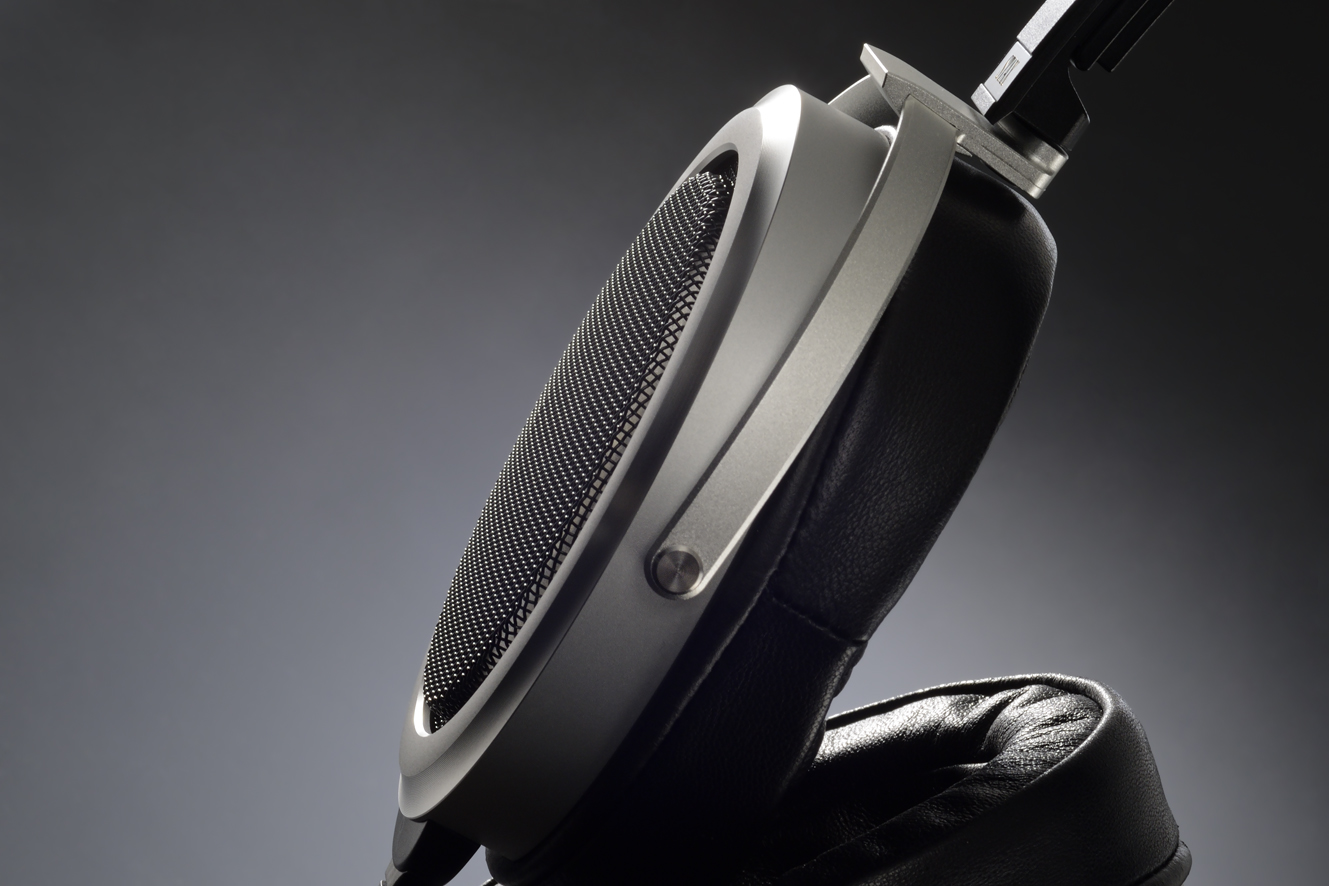
Listening sessions
First, let’s get some operational features out of the way. The power switch feels really solid, with a good ‘click’ action, but there is a slight switch-on transient that is so low in level it’s not a real issue, but it could have been avoided with a ‘soft-start’ circuit.
The volume control has a silky smooth rotational action, with no ‘flick-back’ when you release it so that the volume will always remain exactly where you wanted it in the first place. We are in two minds as to whether we would have liked the SRM-700S’s output volume to be able to be controlled remotely.
Two minds because the presence of the headphone cable means that you can never be too far away from the unit, so accessing the volume control is hardly an issue.
Two minds because, as it happens, our comfiest listening chair is just far enough from the equipment rack that every time we did want to adjust the volume we had to get up from it and walk two paces. We know, first world problems.
A work-around would be to use the external input to bypass the SRM-700’s own volume control, and make sure that you were able to remotely control volume earlier in the equipment chain.
This would be very easy to do, thanks to Stax’s provision of a parallel output on the rear panel. Note however, that although there are both unbalanced and balanced inputs, the paralleled output is only available if you use the unbalanced inputs.
Incidentally, the supplied headphone cable is a very generous 2.5 metres in length but if you’d prefer to sit further away, Stax sells two different extender cables, one 2.5 metres in length (SRE-925S) and the other 5.0 metres in length (SRE-950S). Adding one or the other of these would mean you could sit up to 5 metres or 7.5 metres away respectively.
So with that out of the way, let’s talk about the sound quality. And the very first thing to say is that if you haven’t heard a pair of electrostatic headphones, you are going to be blown away if you listen to a pair of SR-009S earspeakers in combination with the Stax SRM-700S.
We were certainly blown away by the sound quality, and we're more than familiar with how good electrostatic headphones sound, but this combination took things to the next level.
Electrostatic headphones are renowned for their crisp, insightful sound quality, and this was certainly the case with the SRM-700S/SR-009S combination. The very first piece of music we auditioned with this combo was Brahms’ Violin Concerto Op77 in D Major, with Pinchas Zukerman playing with the Los Angeles Philharmonic under the baton of Zubin Mehta.
Right from the outset, the sound of the orchestra was phenomenally good: rich and full, with perfect tonality. As the volume rises to the forté that predicts the entry of the kettledrums, the tension is palpable. We have never heard this work sound so good as it did with this Stax combo.
Then, after the massed orchestral sound, when Zukerman enters around three minutes in, the sound of his violin is exactly as it should be, and perfectly balanced against the orchestra. Higher-pitched notes were reproduced glassily transparently by the Stax combo, and when he adds vibrato... wow! But that was a good preparation for the sound of the flute intro, at which point we were convinced that we don’t think we've ever heard these flutes sound better.
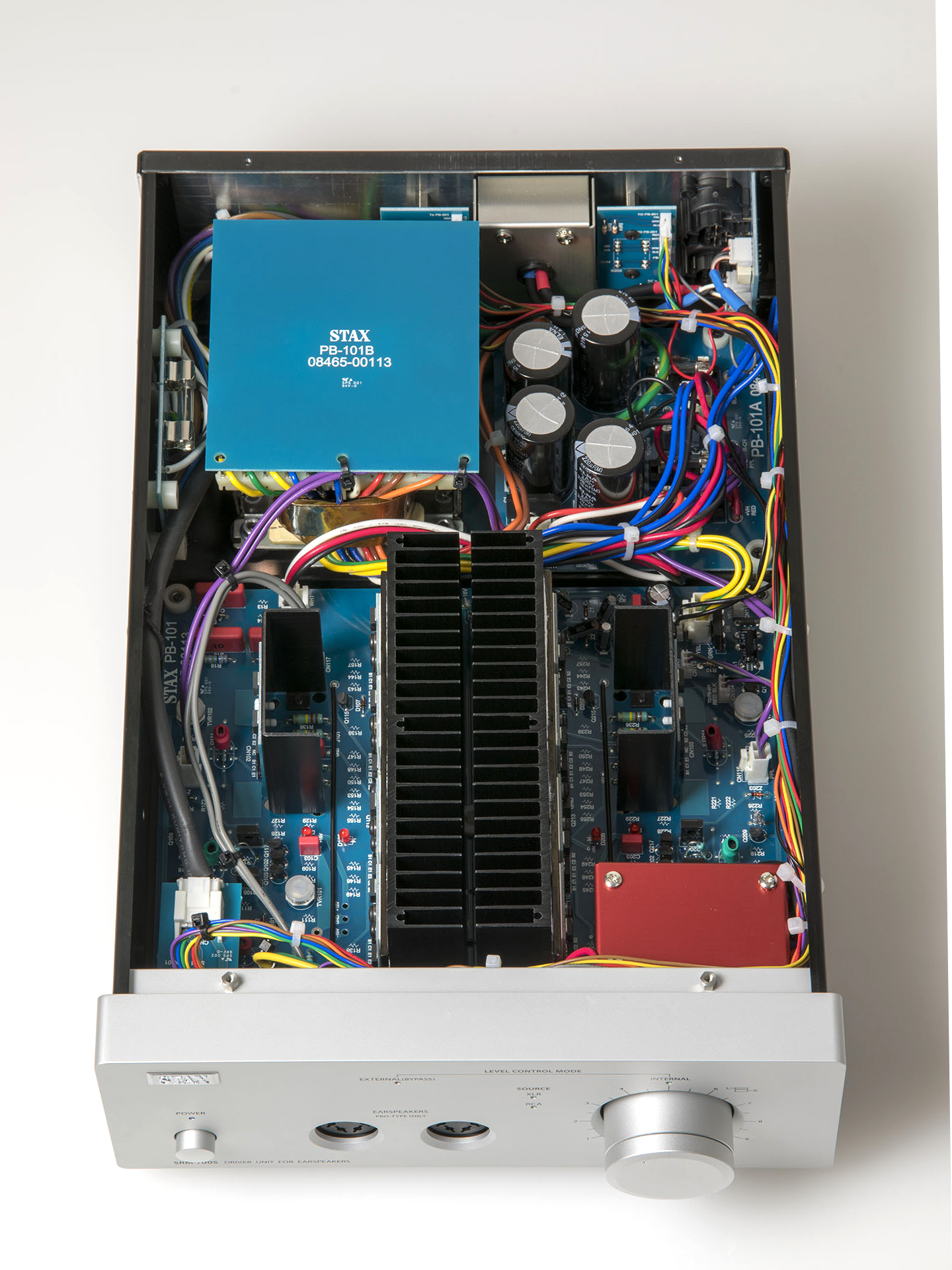
Bass drive from the SRM-700S was outstanding. We thought the SR-009s were very slightly down in level in the deepest bass and perhaps lacking very, very slightly in overall ‘fullness’ of sound, but we could not say that of the new SR-009S design as driven by the SRM-700S. The bass is full, firm, rich and taut.
One thing we particularly noted was that whereas the bass of the older SR-009 design was in part dependent on the air-seal between the earpads and your head, this did not seem to be the case with the new SR-009S model, so there’s a definite improvement in ‘useability’ in this regard.
We should also say that we also prefer the ‘fit’ of the round diaphragms of both models over the fit of the Stax models that have rectangular diaphragms.
High-frequencies were so fluid and airy as to be truly ethereal. There was simply no ‘edge’ to any high-frequency sounds, no matter which instrument was producing them.
We had been thinking about the quality of this airiness whilst listening, and one of the many reasons for it became immediately obvious at the end of the first movement, when the silence when the music stopped was truly profound. The Stax SRM-700S adds absolutely no background noise to the music at all: it’s completely silent. No wonder!
If you’re ever tempted to think that electrostatic headphones can’t rock, you need to take a listen to John Paul Jones’ Zooma, his completely overlooked solo album from 1999, and the first thing he’d done for himself since Led Zeppelin folded. It’s overlooked because it’s an instrumental album... but what an instrumental album it is. Indeed it’s truly a tour de force.
Behind all the tracks are JPJ’s various basses – four-string, ten-string and 12-string. And note that unlike most 12-string basses, which are tuned eeE, aaA, ddD, ggG, JPJ’s are tuned bB-eE-aA-dD-gG-cC which gives an oh-so-different sound. And check out Pete Thomas absolutely crucifying his kit.
When you are listening I’ll bet you can’t resist looking to the left when you hear the laugh towards the end of Bass ‘n’ Drums... the SR-009S/SRM-700S combo makes it sound so real that you will turn your head even if you know there’s no-one in the room with you.
The total lack of background noise, combined with the super-clean, distortion-free sound quality and the perfect balance of the frequencies: the bass is perfectly balanced against the midrange, which in turn is perfectly balanced against the treble, mean that it’s very easy to turn the volume up to potentially ear-damaging levels without really being aware of it, so this is one potential drawback owners would need to take into account.
Final verdict
In our opinion, the performance of Stax’s new SRM-700S is so good that it should be your electrostatic headphone drive amplifier of choice unless you have an absolutely compelling reason to use an SRM-8000T.
But if your only reason to opt for an SRM-8000T is that you want that ‘valve sound’, then our advice would be to buy a Stax SRM-700T. Either way, you’re going to save yourself a heap of dough.
As for your headphones of choice, in an ideal world, that would certainly be the new Stax SR-009S. We could go on and on about why, but you’ll only have to listen to them for a few moments and you’ll know why.
However we are fully aware that not everyone is in a position to spend the kind of money Stax is asking for what is, essentially, a pair of headphones, so we would like to make the point that you don’t actually need an SR-009S/SRM-700S combination in order to enjoy state-of-the-art electrostatic headphone sound, or the legendary Stax quality.
The design and performance of the Stax SR-007 MkII is very close to that of the SR-009S, and it’s around half the price, plus it’s still possible to buy a complete Stax headphone/driver amplifier system (the SRS-3100) for just over a grand. It’s just a matter of taking your first step into that magical electrostatic world... so have a listen! # greg borrowman
